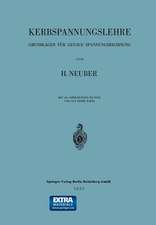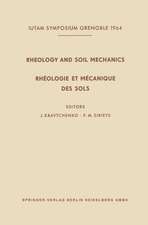Control Theory for Engineers: A Primer
Autor Brigitte d'Andréa-Novel, Michel De Laraen Limba Engleză Hardback – 31 mai 2013
The textbook is organized in the way an engineer classically proceeds to solve a control problem, that is, elaboration of a mathematical model capturing the process behavior, analysis of this model and design of a control to achieve the desired objectives.
It is divided into three Parts. The first part of the text addresses modeling aspects through state space and input-output representations. The notion of the internal state of a system (for example mechanical, thermal or electrical), as well as its description using a finite number of variables, is also emphasized. The second part is devoted to the stability analysis of an equilibrium point. The authors present classical tools for stability analysis, such as linearization techniques and Lyapunov functions.
Central to Control Theory are the notions of feedback and of closed-loop, and the third part of the textbook describes the linear control synthesis in a continuous and discrete-time framework and also in a probabilistic context. Quadratic optimization and Kalman filtering are presented, as well as the polynomial representation, a convenient approach to reject perturbations on the system without making the control law more complex. Throughout the text, different examples are developed, both in the chapters and in the exercises.
| Toate formatele și edițiile | Preț | Express |
|---|---|---|
| Paperback (1) | 998.03 lei 6-8 săpt. | |
| Springer Berlin, Heidelberg – 24 iun 2015 | 998.03 lei 6-8 săpt. | |
| Hardback (1) | 1004.00 lei 6-8 săpt. | |
| Springer Berlin, Heidelberg – 31 mai 2013 | 1004.00 lei 6-8 săpt. |
Preț: 1004.00 lei
Preț vechi: 1224.39 lei
-18% Nou
Puncte Express: 1506
Preț estimativ în valută:
192.12€ • 205.44$ • 160.18£
192.12€ • 205.44$ • 160.18£
Carte tipărită la comandă
Livrare economică 18 aprilie-02 mai
Preluare comenzi: 021 569.72.76
Specificații
ISBN-13: 9783642343230
ISBN-10: 3642343236
Pagini: 276
Ilustrații: XV, 257 p.
Dimensiuni: 155 x 235 x 20 mm
Greutate: 0.56 kg
Ediția:2013
Editura: Springer Berlin, Heidelberg
Colecția Springer
Locul publicării:Berlin, Heidelberg, Germany
ISBN-10: 3642343236
Pagini: 276
Ilustrații: XV, 257 p.
Dimensiuni: 155 x 235 x 20 mm
Greutate: 0.56 kg
Ediția:2013
Editura: Springer Berlin, Heidelberg
Colecția Springer
Locul publicării:Berlin, Heidelberg, Germany
Public țintă
GraduateCuprins
Part I Modelling, Dynamical Systems and Input-Output Representation.- Basics in dynamical system modelling.- Finite dimensional state-space models.- Input-output representation.- Part II Stabilization by State-Space Approach.- Stability of an equilibrium point.- Continuous-time linear dynamical systems.- Discrete-time linear dynamical systems.- Quadratic optimization and linear filtering.- Part III Disturbance Rejection and Polynomial Approach.- Polynomial representation.- Part IV Appendices.- The discrete-time stationary Riccati equation.- Laplace transform and z-transform.- Gaussian vectors.- Bode diagrams.
Recenzii
From the reviews:
“Researchers with a good mathematical background will like this work if they wish to learn the basics of control theory or just need a good reference book with fundamental results on hand. … the book is indeed a primer, and therefore it presents a basic set of topics that are typically addressed in a first course on control theory. … The book can be helpful as a source of simple examples and proofs for a teacher introducing control theory.” (Piotr Cholda, Computing Reviews, April, 2014)
“Researchers with a good mathematical background will like this work if they wish to learn the basics of control theory or just need a good reference book with fundamental results on hand. … the book is indeed a primer, and therefore it presents a basic set of topics that are typically addressed in a first course on control theory. … The book can be helpful as a source of simple examples and proofs for a teacher introducing control theory.” (Piotr Cholda, Computing Reviews, April, 2014)
Textul de pe ultima copertă
Control Theory is at the heart of information and communication technologies of complex systems. It can contribute to meeting the energy and environmental challenges we are facing.
The textbook is organized in the way an engineer classically proceeds to solve a control problem, that is, elaboration of a mathematical model capturing the process behavior, analysis of this model and design of a control to achieve the desired objectives.
It is divided into three Parts. The first part of the text addresses modeling aspects through state space and input-output representations. The notion of the internal state of a system (for example mechanical, thermal or electrical), as well as its description using a finite number of variables, is also emphasized. The second part is devoted to the stability analysis of an equilibrium point. The authors present classical tools for stability analysis, such as linearization techniques and Lyapunov functions.
Central to Control Theory are the notions of feedback and of closed-loop, and the third part of the textbook describes the linear control synthesis in a continuous and discrete-time framework and also in a probabilistic context. Quadratic optimization and Kalman filtering are presented, as well as the polynomial representation, a convenient approach to reject perturbations on the system without making the control law more complex. Throughout the text, different examples are developed, both in the chapters and in the exercises.
The textbook is organized in the way an engineer classically proceeds to solve a control problem, that is, elaboration of a mathematical model capturing the process behavior, analysis of this model and design of a control to achieve the desired objectives.
It is divided into three Parts. The first part of the text addresses modeling aspects through state space and input-output representations. The notion of the internal state of a system (for example mechanical, thermal or electrical), as well as its description using a finite number of variables, is also emphasized. The second part is devoted to the stability analysis of an equilibrium point. The authors present classical tools for stability analysis, such as linearization techniques and Lyapunov functions.
Central to Control Theory are the notions of feedback and of closed-loop, and the third part of the textbook describes the linear control synthesis in a continuous and discrete-time framework and also in a probabilistic context. Quadratic optimization and Kalman filtering are presented, as well as the polynomial representation, a convenient approach to reject perturbations on the system without making the control law more complex. Throughout the text, different examples are developed, both in the chapters and in the exercises.
Caracteristici
The book successfully covers the key concepts and results of Control Theory This includes, in particular, the input-output representation, Routh's criteria, the PID compensator, gain and phase margins, stability and asymptotic stability, Lyapunov functions, controllability, linear state feedback, observer, output regulator, quadratic optimization, Kalman-Bucy filter, polynomial representation, disturbance rejection The level of mathematics is geared to engineers, and the book gives various examples





























